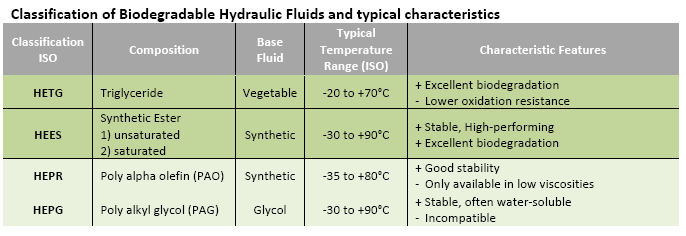Home News Technical Topic: Biodegradable Hydraulic Fluids
Technical Topic: Biodegradable Hydraulic Fluids

Overview of Biodegradable Hydraulic Oils
Category of Biodegradable Hydraulic Oils is governed by the internationally accepted standard ISO 15380 (2016) and technical rule VDMA 24568 (1994).
ISO 15380 standard specifies the requirements for biodegradable hydraulic oils in 4 main material product groups: HETG, HEPG, HEES and HEPR. The minimum content of base fluid for each product group shall not be less than 70 % (m/m).
1. Vegetable Oils – HETG
(Hydraulic Oil Environmental TriGlyceride)
HETG’s are technically limited by lower resistance to oxidation and temperature stability, as result of their “double bond”. HETG oils feature very high levels of biodegradability and are used in older, less demanding, hydraulic systems. For technically highly demanding hydraulic applications HETG’s are not fully suitable.
2. Synthetic Esters - HEES
(Hydraulic Oil Environmental Ester Synthetic)
Due to technical and environmental capability HEES products currently lead in the category of biodegradable hydraulic fluids.
Group HEES further splits into 2 sub-categories with different levels of performance properties:
a) Unsaturated (or partially saturated) synthetic esters are products based on vegetable resources or their mixtures. Their technical applicability in high demanding applications individually depends on composition of the mixture.
b) Saturated synthetic esters currently provide the most sophisticated, environmentally acceptable solution
for hydraulic systems. Technical advantages of saturated synthetic esters are performance benefits, extreme stability, wide temperature range, compatibility, high levels of biodegradation and renewable resources.
3. PAO and related products - HEPR
(Hydraulic Oil Environmental PAO and Related)
HEPR oils are technically well developed products. However, their environmental acceptance is often compromised (similar to HEPG). HEPR‘s are produced in very low viscosities, limiting their primary applicability. Viscosity modifiers are required to improve their usability in common hydraulic applications.
4. Polyglycol Oils - HEPG
(Hydraulic Oil Environmental PolyGlycol)
Performance-wise HEPG’s are highly sophisticated products. However, their severely limiting factors are incompatibility with paint, sealing materials, hoses, and virtually any other type of hydraulic oil. HEPG’s are also questioned for poor biodegradation and not meeting criteria for renewable resources, e.g. unable to obtain Ecolabels. HEPG oils are used only on a small scale.

Související produkty
BIHOL (HETG)
BIHOL is readily biodegradable rapeseed oil based hydraulic lubricants offering an excellent level of lubrication and an improved operating temperature range. Developed to replace the usual mineral oil based hydraulic lubricants to reduce an environmental footprint.
Product DetailHydraulic Oil PLUS (HEES)
Hydraulic Oil PLUS presents a high performance, fully synthetic, zinc-free, readily biodegradable hydraulic fluid based on a mixture of saturated and unsaturated synthetic esters.
Product DetailPREMIUM Hydraulic Oil (HEES)
PREMIUM Hydraulic Oil is ultimate performance, fully synthetic, zinc-free, readily biodegradable hydraulic oil based on top-tier fully saturated synthetic esters.
Product Detail Producer of bio-oils and plastic lubricants
Producer of bio-oils and plastic lubricants
